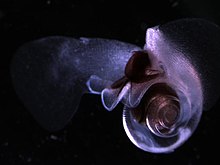Limacina
| Limacina | |
|---|---|
 |
|
| Limacina helicina | |
| Scientific classification | |
| Kingdom: | Animalia |
| Phylum: | Mollusca |
| Class: | Gastropoda |
| (unranked): |
clade Heterobranchia clade Euthyneura |
| Superfamily: | Limacinoidea |
| Family: | Limacinidae |
| Genus: |
Limacina Bosc, 1817 |
| Type species | |
|
Clio helicina Phipps, 1774 |
|
| Species | |
|
See text. |
|
| Synonyms | |
|
|
clade Euthyneura
clade Euopisthobranchia
clade Thecosomata
See text.
Limacina is a genus of swimming predatory sea snails commonly known as sea butterflies in the family Limacinidae. This genus contains some of the world's most abundant gastropod species.
Etymological meaning of the generic name Limacina is "snail-like".
As pelagic marine gastropods, Limacina swim by flapping their parapodia, inspiring the common name sea butterflies.
Sea butterflies are part of the clade Thecosomata. Sea angels, similar to Limacina, are in the order Gymnosomata. Both of these orders are still referred to as "pteropods". Sea butterflies of the order Thecosomata have a shell, while sea angels in the order Gymnosomata do not.
The shells of Limacina are well developed, sinistrally coiled, turret-like, and include an operculum. Shell size and thickness vary within the genus. At high latitudes, the diameter of the shell does not exceed 15 mm. At lower latitudes, the diameter varies from 1 to 3 mm.
Two large winglike parapodia, derived from foot tissue, propel these invertebrates through the water column to overcome negative buoyancy due to the animal's shell. As diel vertical migrators, Limacina inhabit deeper waters during the day and travel to the surface at night to feed.
...
Wikipedia
